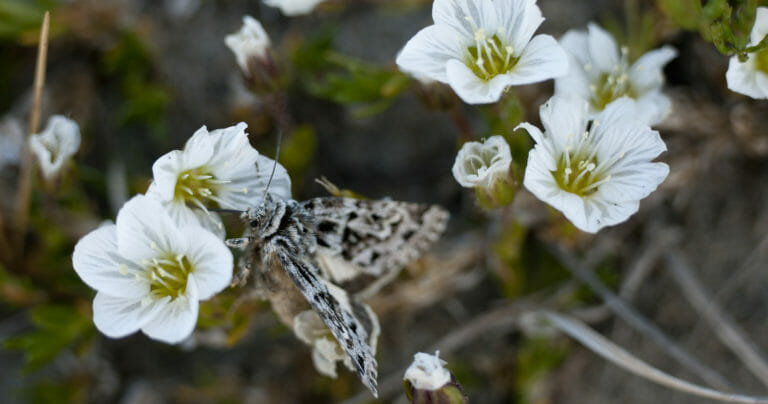Arctic Species Changing as the Climate Warms
There are more herbivores and creatures that parasitize other animals, but those that consume carrion and decomposing plants seem to be on the way down, scientists say. Moths are among the Arctic species reacting to warming. (US NPS / Wikimedia Commons)
Moths are among the Arctic species reacting to warming. (US NPS / Wikimedia Commons)
Global warming is beginning to change the high Arctic species which make up the region’s most numerous occupants. Scientists who have been collecting spiders, mites, ticks, bugs, bees, wasps, ants, moths and springtails in the northeast of Greenland report that the arthropod population is starting to respond to the changing seasons.
Arthropods make up the largest variety of animals on the planet: this is a phylum of jointy-legged things with exoskeletons that includes spiders as well as flies, bees and butterflies as well as mites. In the tundra, the mass of arthropods is greater than that of birds or mammals.
Danish and US scientists report in the Royal Society journal Open Science that between 1996 and 2014, researchers collected 593,788 specimens of different arthropod groups around the Zackenberg research station and noted the way the species composition of a population changed with time and with the pattern of summer rainfall.
In this region, the winter temperatures fall to minus 30°C [-22 F] and average annual temperature is minus 9°C [15.8 F]. The ground is more or less permanently frozen. But in the brief Arctic summer, temperatures can soar to between 3°C [37.4] and 7°C [44.6] and the Arctic fens, heaths and arid zones effervesce with life.
Compared with the past, the population is changing. There are more herbivores and creatures that parasitise other animals, but the detritivores – the creatures that consume carrion, excrement and decomposing plants – seem to be on the way down, with, the scientists say, potential implications for key ecosystem processes such as decomposition, nutrient cycling and primary productivity.
Change varied according to habitat: the changes in the composition of the community of arthropods were up to five times more extreme in the drier ecosystems. The implication of such research is that study of shorter-lived, tinier creatures may provide more information about adaptation and loss in the rapidly warming Arctic than, for instance, study of seals and polar bears.
And the insects do respond, even to subtle change: researchers four years ago noted that around 80 species of moth inside Finland’s Arctic seemed to be coping with warmer summers.
“Twenty years may not be long enough to detect changes in abundances of longer-lived species, like some mammals, but because of their short life spans, it’s a pretty long time for arthropods. Still, the fact that we can detect changes over 20 years in some of these animal groups at such a coarse taxonomic resolution is remarkable,” said Amanda Koltz, of Washington University in St Louis, who led the study.
“We often don’t pay much attention to these small animals, but there could be real consequences to their changing abundances.”
Your support is crucial…With an uncertain future and a new administration casting doubt on press freedoms, the danger is clear: The truth is at risk.
Now is the time to give. Your tax-deductible support allows us to dig deeper, delivering fearless investigative reporting and analysis that exposes what’s really happening — without compromise.
Stand with our courageous journalists. Donate today to protect a free press, uphold democracy and unearth untold stories.









You need to be a supporter to comment.
There are currently no responses to this article.
Be the first to respond.